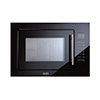| Sep 09, 2022 |
|
(Nanowerk News) A household microwave oven modified by a Cornell Engineering professor is helping to cook up the next generation of cellphones, computers and other electronics after the invention was shown to overcome a major challenge faced by the semiconductor industry.
|
|
The research is detailed in a paper in Applied Physics Letters (“Efficient and stable activation by microwave annealing of nanosheet silicon doped with phosphorus above its solubility limit”). The lead author is James Hwang, a research professor in the Department of Materials Science and Engineering; other Cornell contributors are doctoral student Chandrasekhar Savant and former postdoctoral researcher Mohammed Javad Asadi.
|
 |
| James Hwang, research professor in the Department of Materials Science and Engineering, right, at his modified microwave with Gianluca Fabi holding a semiconductor at left. (Image: Ryan Young, Cornell University)
|
|
Producing the materials that make up transistors and other microchip components is similar to baking in that material ingredients must be mixed together and then heated, among other steps, in order to produce a desired electrical current. For instance, phosphorus is added to silicon and then the mixture is annealed, or heated, to position the phosphorus atoms into the correct place so that they are active in current conduction.
|
|
But as microchips continue to shrink, the silicon must be doped, or mixed, with higher concentrations of phosphorus to produce the desired current. Semiconductor manufacturers are now approaching a critical limit in which heating the highly doped materials using traditional methods no longer produces consistently functional semiconductors.
|
|
“We need concentrations of phosphorus that are higher than its equilibrium solubility in silicon. That goes against nature,” Hwang said. “The silicon crystal expands, causing immense strain and making it potentially useless for electronics.”
|
|
The Taiwan Semiconductor Manufacturing Company (TSMC) had theorized that microwaves could be used to activate the excess dopants, but just like with household microwave ovens that sometimes heat food unevenly, previous microwave annealers produced “standing waves” that prevented consistent dopant activation. So TSMC partnered with Hwang, who modified a microwave oven to selectively control where the standing waves occur. Such precision allows for the proper activation of the dopants without excessive heating or damage of the silicon crystal.
|
|
This discovery could be used to produce semiconductor materials and electronics appearing around the year 2025, said Hwang, who has filed two patents for the prototype microwave annealer with postdoctoral researcher Gianluca Fabi.
|
|
“A few manufacturers are currently producing semiconductor materials that are 3 nanometers,” Hwang said. “This new microwave approach can potentially enable leading manufacturers such as TSMC and Samsung to scale down to just 2 nanometers.”
|
|
The breakthrough could change the geometry of transistors used in microchips. For more than 20 years, transistors have been made to stand up like dorsal fins so that more can be packed on each microchip, but manufacturers have recently begun to experiment with a new architecture in which transistors are stacked horizontally as nanosheets that can further increase the density and control of transistors. The excessively doped materials enabled by microwave annealing would be key to the new architecture.
|


